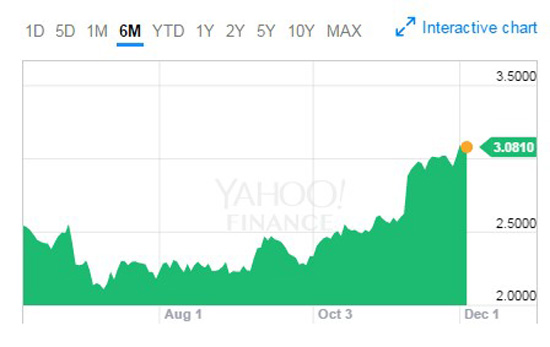Stocks paused from their post-election rally last week as the Dow Jones Industrial Average gained a paltry 18.28 points, or 0.1%, to end the week at 19,170.42. The S&P 500 fell 1% to 2,191.96, while the Nasdaq Composite Index fell 2.65% to 5,255.65. Further gains or losses may be less dependent on news from Trump Tower and more responsive to Italian voters' rejection of constitutional reform on Sunday, Dec. 4.
The "no" vote in Italy bodes poorly for Italian banks, which are insolvent and in need of government support, and is potentially a movement toward exiting the European Union. Despite a wider than expected margin of defeat ("no" votes were nearly 60% of the total), markets surprised in Europe and the United States by rallying. I have to confess that while I expected the "no" vote, I did not expect markets to greet the result by rallying and am scratching my head at the response.
Italian voters are the latest to embrace populism and reject the elites governing their country. Following the Brexit vote and Donald Trump's victory, Italians rejected much-needed constitutional reforms that could improve governance and chances for economic reform because they were focused on rejecting the heavy hand of the European Union and the straitjacket of the single currency that is suffocating their economy.
 This is what happened in the UK and points to the likelihood that the European Union is doomed in the long term. For the moment, however, the immediate threat from this vote is to the insolvent Italian banking system that desperately needs to restructure. In the coming days, markets may come to see the vote with dark rather than rose-colored glasses, as I do.
This is what happened in the UK and points to the likelihood that the European Union is doomed in the long term. For the moment, however, the immediate threat from this vote is to the insolvent Italian banking system that desperately needs to restructure. In the coming days, markets may come to see the vote with dark rather than rose-colored glasses, as I do.
Get Our Best Wealth-Building Ideas: Money Morning's top 5 investment reports to grow your money like never before are right here - and they're absolutely free. Read more...
The U.S. Dollar Index faded a bit last week but still closed at 100.66, near its 52-week high. On a broad basis, U.S. stocks are now engaged in a battle between expectations of higher growth and earnings due to Trump's pro-growth and lower tax agenda and the costs of higher interest rates and a more expensive dollar. The market is expensive, with the S&P 500 Market Cap/GDP Ratio at 125%, near a historic high, and the Shiller Cyclically-Adjusted Price Earnings Ratio at 27.02 versus its historical mean of 16.71.
While these valuation metrics aren't deterring investors yet, they indicate that the market is very vulnerable to disappointments - and disappointments can come from many economic and geopolitical fronts. With higher rates and European instability on the horizon, investors should proceed with caution. That may not happen until year-end performance chasing is over, but I would expect the rally to peter out in January.
Truth be told, stocks aren't a reliable indicator of anything right now.
The real "brains" of the market (and the real profit opportunities) lie elsewhere.
Here's what you should be watching instead.
[mmpazkzone name="in-story" network="9794" site="307044" id="137008" type="4"]
In a Misleading Market Climate, One Indicator Tells the Truth
Markets are still driven by phony government statistics that paint a false picture of the economy. The November jobs report is a typical case in point. The government reported that the economy added 178,000 jobs in November and that the unemployment rate dropped to a nine-year low of 4.6%. But this is nonsense. The only reason the unemployment rate dropped so low was that over 400,000 people left the work force, distorting the calculation. In point of fact, if the labor participation rate (which remains at 40-year lows) was the same today as when Barack Obama began his disastrous presidency in January 2009, the unemployment rate would be over 10%.
The only good thing about this phony number is that the members of the Federal Reserve's Open Market Committee (FOMC) are dumb enough to believe it and use it to guide policy; in this case, it means that they will raise short-term interest rates by 25 basis points on Dec. 15. In doing so, the intellectuals-yet-idiots who manage monetary policy will no doubt cite the phony low unemployment rate as one justification for their action when in fact low rates contribute to the low labor participation rate and sluggish wage growth, but at least they will move one tortoise-like step closer to normalizing interest rates. When they hiked rates for the first time in nearly a decade last December, the market threw a tantrum that sent the S&P 500 down 10% in January before it recovered. Whether markets will react any better this time remains to be seen, though the psychological boost from the Trump victory will likely cushion any negative blow.
Some speculative stocks are skyrocketing as a result of expectations about the new administration that have no basis in reality. For example, Fannie Mae (FNMA) and Freddie Mac (FMCC) are up sharply since the election based on unfounded speculation that the Trump administration will allow the shareholders of these government-owned entities to share in their recovery since the financial crisis, despite legislation that swept all of their profits into the government's hands.
Don't Miss: The Essential Guide to Buying Gold & Silver
Ignoring the fact that both companies' profits are shrinking, that they have no capital base as a result of their past losses and government profit sweep, and that they may need more government help in the near future, investors are convincing themselves that a Trump administration will reward a bunch of hedge fund speculators who were nowhere to be found when the companies needed capital in 2008. Naturally, the Obama administration handled the entire matter in an underhanded way that created an opening for sharp operators to sue the government to try to profit off the backs of American taxpayers, but the odds of shareholders prevailing here remain slim. Investors chase these gains at their own peril.
Right now, Wall Street strategists are busy tripping over themselves raising their 2017 targets for the S&P 500 based on President-elect Trump's pro-growth agenda. But while stock prices rally, the real brains of the market - the bond market - is selling off awfully hard.
The yield on 10- and 30-year Treasuries are up to 2.38% and 3.06%, respectively, after rising more than half a percentage point since the election.
30-Year Treasury Yield

The rise in yields already produced $1.7 trillion in losses, but these are only a small down payment on the catastrophic losses holders of investment-grade corporate and sovereign debt are likely to experience over the next few years. If rates were to normalize by 200 basis points (which is a near certainty over the next three to four years), that would bring losses to over $7 trillion (though there would be some offset from interest income - at least where bonds are not showing negative yields).
The bottom line is that bonds remain a toxic asset class that should be avoided by investors at all costs. In case that sentence wasn't clear enough, that means that everyone reading this should sell every single long-dated (i.e., longer than three years) investment-grade, municipal, or government bond you own in order to avoid losing money on both a nominal and real (i.e., inflation-adjusted) basis. Either stick the money in cash or use some of the money to buy gold (which is selling off for stupid reasons). Professional and sophisticated investors should consider shorting every piece of long-dated, high-quality debt on which they can get their hands.
One way to do that is to short the Vanguard Total Return International Bond ETF (Nasdaq: BNDX), which carries a very low yield that is heading higher and will lead to big losses. As always, I recommend puts as a safer (and cheaper) way to play the short side.
Of course, you should keep an eye out on our short equity plays, too, because we've seen bad news for some of them very recently...
A Note on One of Our Favorite Short Plays
Valeant Pharmaceuticals International Inc. (NYSE: VRX) received more bad news last week after a proposed deal to sell its Salix business for a multibillion-dollar loss fell through. It is becoming increasingly obvious to the market that VRX is insolvent and that its stock has no value, something I warned about a long time ago when the stock was trading at $170 per share (no, I didn't catch the high tick at $262, but nobody's perfect!). It ended the week at $15.45 per share. It is going to zero.
This Stock Is About to Skyrocket: This tiny $5 company just passed each of the seven benchmarks in this secret stock-picking method. Learn how to get in before its revenue surges an estimated 4,709%. Read more...
Follow Money Morning on Facebook and Twitter.
About the Author
Prominent money manager. Has built top-ranked credit and hedge funds, managed billions for institutional and high-net-worth clients. 29-year career.



